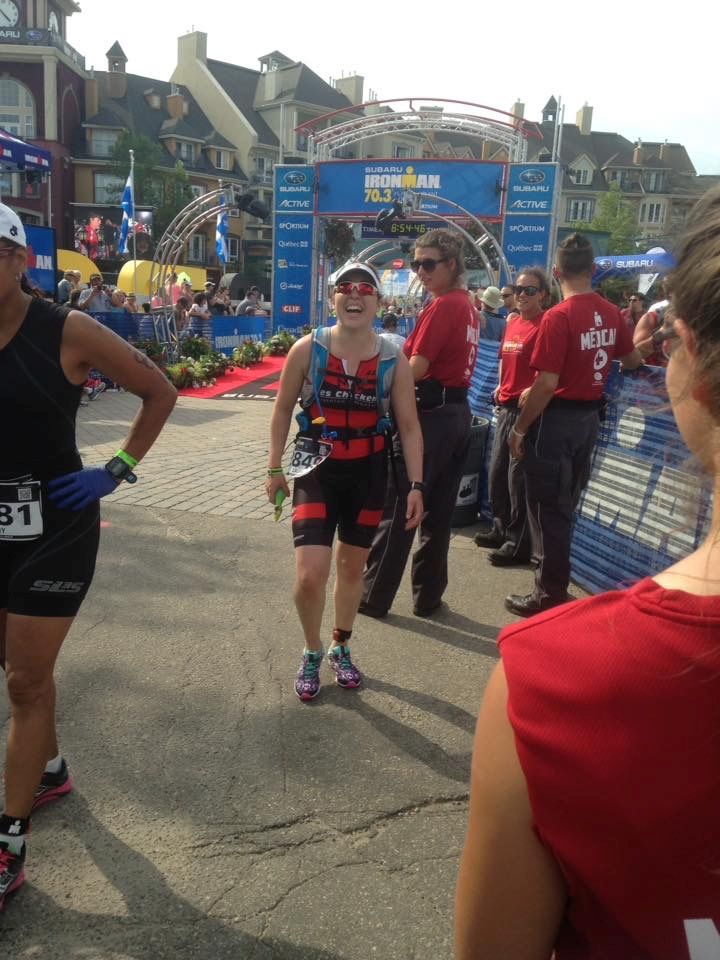User login
Residency is like an IRONMAN
At the end of my junior surgical residency years, I was in a pretty bad physical and mental space. With resident coverage shortages, long hours, chronic fatigue, and personal pressures to perform and shine, I wound up digging myself into a hole, heading straight to resident burnout. Although there were others around me experiencing similar environmental stressors, I certainly felt alone – not knowing how to climb out of the hole I created for myself.
This was probably the lowest I have been in my life, but I finally got myself back on track. Coming from a fairly physically active background, I returned to a life of proper nutrition and physical activity. I began swimming, biking, and running, with the hopes of maybe one day doing a triathlon. There were a few health care professionals at my institution who competed in yearly triathlons, which certainly inspired me to take up the sport. So, last August, I signed up for my first Half-IRONMAN in Mont-Tremblant, Quebec, and had roughly 10 months to train. Looking back, I am not sure what possessed me to think I could achieve such a feat, but it was certainly a goal to work toward.
First, take it slow and steady. Residency is long and arduous, and it is easy to overpace yourself in the first few months – but keep in mind that you are in it for the long haul (for some, it’s longer than 5 years).
Second, be nice to your body and mind. You wouldn’t believe how some of the most-challenging experiences are all psychological; therefore, eat well, sleep well, and practice mindfulness every day. Develop a routine early on, so that when you meet grueling experiences and challenges, your routine will make you equipped to overcome them. The practice of mindfulness (a mental state of being aware in the present moment) will be unique to each individual and may be performed through exercising, yoga, or more traditionally, through meditation. Third, develop or strengthen a support system to help you identify and overcome problems that you may face during residency.
Ideally, this will be a support system (for example, residents, coworkers, and staff) that know exactly what you will be facing and offer constructive advice for the trials and tribulations you will be confronting. Finally, residency will be the most-challenging experience you may go through yet in your pursuit of postgraduate medical education. You are not alone on this journey, and the path to success will be burdened with physical and mental exhaustion, tears, groans, as well as smiles. But when you cross that finish line, let me tell you that the emotions that will overwhelm you will be those of complete exuberance and utter disbelief that you had the courage and determination to not only undertake the challenge but to succeed, as well.
At the end of my junior surgical residency years, I was in a pretty bad physical and mental space. With resident coverage shortages, long hours, chronic fatigue, and personal pressures to perform and shine, I wound up digging myself into a hole, heading straight to resident burnout. Although there were others around me experiencing similar environmental stressors, I certainly felt alone – not knowing how to climb out of the hole I created for myself.
This was probably the lowest I have been in my life, but I finally got myself back on track. Coming from a fairly physically active background, I returned to a life of proper nutrition and physical activity. I began swimming, biking, and running, with the hopes of maybe one day doing a triathlon. There were a few health care professionals at my institution who competed in yearly triathlons, which certainly inspired me to take up the sport. So, last August, I signed up for my first Half-IRONMAN in Mont-Tremblant, Quebec, and had roughly 10 months to train. Looking back, I am not sure what possessed me to think I could achieve such a feat, but it was certainly a goal to work toward.
First, take it slow and steady. Residency is long and arduous, and it is easy to overpace yourself in the first few months – but keep in mind that you are in it for the long haul (for some, it’s longer than 5 years).
Second, be nice to your body and mind. You wouldn’t believe how some of the most-challenging experiences are all psychological; therefore, eat well, sleep well, and practice mindfulness every day. Develop a routine early on, so that when you meet grueling experiences and challenges, your routine will make you equipped to overcome them. The practice of mindfulness (a mental state of being aware in the present moment) will be unique to each individual and may be performed through exercising, yoga, or more traditionally, through meditation. Third, develop or strengthen a support system to help you identify and overcome problems that you may face during residency.
Ideally, this will be a support system (for example, residents, coworkers, and staff) that know exactly what you will be facing and offer constructive advice for the trials and tribulations you will be confronting. Finally, residency will be the most-challenging experience you may go through yet in your pursuit of postgraduate medical education. You are not alone on this journey, and the path to success will be burdened with physical and mental exhaustion, tears, groans, as well as smiles. But when you cross that finish line, let me tell you that the emotions that will overwhelm you will be those of complete exuberance and utter disbelief that you had the courage and determination to not only undertake the challenge but to succeed, as well.
At the end of my junior surgical residency years, I was in a pretty bad physical and mental space. With resident coverage shortages, long hours, chronic fatigue, and personal pressures to perform and shine, I wound up digging myself into a hole, heading straight to resident burnout. Although there were others around me experiencing similar environmental stressors, I certainly felt alone – not knowing how to climb out of the hole I created for myself.
This was probably the lowest I have been in my life, but I finally got myself back on track. Coming from a fairly physically active background, I returned to a life of proper nutrition and physical activity. I began swimming, biking, and running, with the hopes of maybe one day doing a triathlon. There were a few health care professionals at my institution who competed in yearly triathlons, which certainly inspired me to take up the sport. So, last August, I signed up for my first Half-IRONMAN in Mont-Tremblant, Quebec, and had roughly 10 months to train. Looking back, I am not sure what possessed me to think I could achieve such a feat, but it was certainly a goal to work toward.
First, take it slow and steady. Residency is long and arduous, and it is easy to overpace yourself in the first few months – but keep in mind that you are in it for the long haul (for some, it’s longer than 5 years).
Second, be nice to your body and mind. You wouldn’t believe how some of the most-challenging experiences are all psychological; therefore, eat well, sleep well, and practice mindfulness every day. Develop a routine early on, so that when you meet grueling experiences and challenges, your routine will make you equipped to overcome them. The practice of mindfulness (a mental state of being aware in the present moment) will be unique to each individual and may be performed through exercising, yoga, or more traditionally, through meditation. Third, develop or strengthen a support system to help you identify and overcome problems that you may face during residency.
Ideally, this will be a support system (for example, residents, coworkers, and staff) that know exactly what you will be facing and offer constructive advice for the trials and tribulations you will be confronting. Finally, residency will be the most-challenging experience you may go through yet in your pursuit of postgraduate medical education. You are not alone on this journey, and the path to success will be burdened with physical and mental exhaustion, tears, groans, as well as smiles. But when you cross that finish line, let me tell you that the emotions that will overwhelm you will be those of complete exuberance and utter disbelief that you had the courage and determination to not only undertake the challenge but to succeed, as well.
Obesity and Gynecologic Cancer
For the last decade, the obesity epidemic in the United States has been well recognized. In 2001, the surgeon general made a call to action to combat obesity. Despite this effort, obesity rates in the United States continued to rise, and in 2009-2010, more than one third (35.7%) of adults in the United States were classified as obese, according to the Centers for Disease Control and Prevention.
The definition of obesity relies on the body mass index. BMI is defined as a person’s weight in kilograms divided by the individual’s height in meters squared. Overweight is defined as a BMI of 25-29.9 kg/m2 and obesity as a BMI of greater than 30 kg/m2. Obesity has been further classified by the World Health Organization into class I (BMI, 30-34.9 kg/m2), class II (BMI, 35-39.9 kg/ m2), and class III (BMI, greater than 40 kg/ m2).
In the United States in 2013, there were approximately 50,000 new cases and more than 8,000 deaths from endometrial cancer (CA Cancer J. Clin. 2013;63:11-30). Rates of endometrial cancer have risen steadily along with the obesity epidemic. This is no surprise, as obesity has been linked to the development of endometrial cancer. It is believed that high levels of circulating estrogen created by adipose tissue convert androstenedione to estrone, and there is aromatization of androgens. For each 5-kg/m2 increase in BMI, there is an increased risk of development of endometrial cancer (relative risk, 1.59) (Lancet 2008;371:569). While many physicians realize the link between obesity and the hyperestrogenic state associated with endometrial cancers, increased BMI is also associated with an increased risk of ovarian cancer (odds ratio, 1.3) (Eur. J. Cancer 2007;43:690).
In addition to increasing the risk of developing gynecologic cancers, obesity also increases the risk of death from all gynecologic malignancies. In the Cancer Prevention Study II, a large prospective cohort study, a BMI greater than 35 was associated with increased mortality compared with normal weight in ovarian (RR, 1.51), endometrial (RR, 2.77), and cervical cancer (RR, 3.20) (N. Engl. J. Med. 2003;348:1625). The same study found that those with a BMI greater than 40 with endometrial cancer had a relative risk of death of 6.25.
The increased mortality seen in obese endometrial cancer patients is particularly striking, given the fact that these women are more likely to have less-aggressive histologies and earlier-stage cancers (Gynecol. Oncol. 2009;90:150-7; Gynecol. Oncol. 2009;114:121-7). This highlights the importance of weight loss and healthy lifestyle choices in this population. The American Cancer Society recommends focusing on healthy lifestyles in cancer survivors. Key recommendations include the maintenance of healthy weight or weight loss for the overweight/obese, physical activity with at least 30 minutes of moderate activity on 5 or more days per week, a healthy diet with at least five servings of fruits and vegetables per day with limited processed foods and red meats, and limited alcohol intake (CA Cancer J. Clin. 2012;62:243).
Practicing gynecologists should appreciate the increasing rates of endometrial cancer and remain highly suspicious of abnormal uterine bleeding in their obese patients. Early detection of cancers and modification of lifestyle remain the mainstay of improving outcomes in obese patients.
Dr. Gehrig is professor and director of gynecologic oncology at the University of North Carolina at Chapel Hill. Dr. Clark is a chief resident in the department of obstetrics and gynecology at the university. Dr. Gehrig and Dr. Clark have no relevant conflicts of interest.*
* This story was updated 1/27/2014
For the last decade, the obesity epidemic in the United States has been well recognized. In 2001, the surgeon general made a call to action to combat obesity. Despite this effort, obesity rates in the United States continued to rise, and in 2009-2010, more than one third (35.7%) of adults in the United States were classified as obese, according to the Centers for Disease Control and Prevention.
The definition of obesity relies on the body mass index. BMI is defined as a person’s weight in kilograms divided by the individual’s height in meters squared. Overweight is defined as a BMI of 25-29.9 kg/m2 and obesity as a BMI of greater than 30 kg/m2. Obesity has been further classified by the World Health Organization into class I (BMI, 30-34.9 kg/m2), class II (BMI, 35-39.9 kg/ m2), and class III (BMI, greater than 40 kg/ m2).
In the United States in 2013, there were approximately 50,000 new cases and more than 8,000 deaths from endometrial cancer (CA Cancer J. Clin. 2013;63:11-30). Rates of endometrial cancer have risen steadily along with the obesity epidemic. This is no surprise, as obesity has been linked to the development of endometrial cancer. It is believed that high levels of circulating estrogen created by adipose tissue convert androstenedione to estrone, and there is aromatization of androgens. For each 5-kg/m2 increase in BMI, there is an increased risk of development of endometrial cancer (relative risk, 1.59) (Lancet 2008;371:569). While many physicians realize the link between obesity and the hyperestrogenic state associated with endometrial cancers, increased BMI is also associated with an increased risk of ovarian cancer (odds ratio, 1.3) (Eur. J. Cancer 2007;43:690).
In addition to increasing the risk of developing gynecologic cancers, obesity also increases the risk of death from all gynecologic malignancies. In the Cancer Prevention Study II, a large prospective cohort study, a BMI greater than 35 was associated with increased mortality compared with normal weight in ovarian (RR, 1.51), endometrial (RR, 2.77), and cervical cancer (RR, 3.20) (N. Engl. J. Med. 2003;348:1625). The same study found that those with a BMI greater than 40 with endometrial cancer had a relative risk of death of 6.25.
The increased mortality seen in obese endometrial cancer patients is particularly striking, given the fact that these women are more likely to have less-aggressive histologies and earlier-stage cancers (Gynecol. Oncol. 2009;90:150-7; Gynecol. Oncol. 2009;114:121-7). This highlights the importance of weight loss and healthy lifestyle choices in this population. The American Cancer Society recommends focusing on healthy lifestyles in cancer survivors. Key recommendations include the maintenance of healthy weight or weight loss for the overweight/obese, physical activity with at least 30 minutes of moderate activity on 5 or more days per week, a healthy diet with at least five servings of fruits and vegetables per day with limited processed foods and red meats, and limited alcohol intake (CA Cancer J. Clin. 2012;62:243).
Practicing gynecologists should appreciate the increasing rates of endometrial cancer and remain highly suspicious of abnormal uterine bleeding in their obese patients. Early detection of cancers and modification of lifestyle remain the mainstay of improving outcomes in obese patients.
Dr. Gehrig is professor and director of gynecologic oncology at the University of North Carolina at Chapel Hill. Dr. Clark is a chief resident in the department of obstetrics and gynecology at the university. Dr. Gehrig and Dr. Clark have no relevant conflicts of interest.*
* This story was updated 1/27/2014
For the last decade, the obesity epidemic in the United States has been well recognized. In 2001, the surgeon general made a call to action to combat obesity. Despite this effort, obesity rates in the United States continued to rise, and in 2009-2010, more than one third (35.7%) of adults in the United States were classified as obese, according to the Centers for Disease Control and Prevention.
The definition of obesity relies on the body mass index. BMI is defined as a person’s weight in kilograms divided by the individual’s height in meters squared. Overweight is defined as a BMI of 25-29.9 kg/m2 and obesity as a BMI of greater than 30 kg/m2. Obesity has been further classified by the World Health Organization into class I (BMI, 30-34.9 kg/m2), class II (BMI, 35-39.9 kg/ m2), and class III (BMI, greater than 40 kg/ m2).
In the United States in 2013, there were approximately 50,000 new cases and more than 8,000 deaths from endometrial cancer (CA Cancer J. Clin. 2013;63:11-30). Rates of endometrial cancer have risen steadily along with the obesity epidemic. This is no surprise, as obesity has been linked to the development of endometrial cancer. It is believed that high levels of circulating estrogen created by adipose tissue convert androstenedione to estrone, and there is aromatization of androgens. For each 5-kg/m2 increase in BMI, there is an increased risk of development of endometrial cancer (relative risk, 1.59) (Lancet 2008;371:569). While many physicians realize the link between obesity and the hyperestrogenic state associated with endometrial cancers, increased BMI is also associated with an increased risk of ovarian cancer (odds ratio, 1.3) (Eur. J. Cancer 2007;43:690).
In addition to increasing the risk of developing gynecologic cancers, obesity also increases the risk of death from all gynecologic malignancies. In the Cancer Prevention Study II, a large prospective cohort study, a BMI greater than 35 was associated with increased mortality compared with normal weight in ovarian (RR, 1.51), endometrial (RR, 2.77), and cervical cancer (RR, 3.20) (N. Engl. J. Med. 2003;348:1625). The same study found that those with a BMI greater than 40 with endometrial cancer had a relative risk of death of 6.25.
The increased mortality seen in obese endometrial cancer patients is particularly striking, given the fact that these women are more likely to have less-aggressive histologies and earlier-stage cancers (Gynecol. Oncol. 2009;90:150-7; Gynecol. Oncol. 2009;114:121-7). This highlights the importance of weight loss and healthy lifestyle choices in this population. The American Cancer Society recommends focusing on healthy lifestyles in cancer survivors. Key recommendations include the maintenance of healthy weight or weight loss for the overweight/obese, physical activity with at least 30 minutes of moderate activity on 5 or more days per week, a healthy diet with at least five servings of fruits and vegetables per day with limited processed foods and red meats, and limited alcohol intake (CA Cancer J. Clin. 2012;62:243).
Practicing gynecologists should appreciate the increasing rates of endometrial cancer and remain highly suspicious of abnormal uterine bleeding in their obese patients. Early detection of cancers and modification of lifestyle remain the mainstay of improving outcomes in obese patients.
Dr. Gehrig is professor and director of gynecologic oncology at the University of North Carolina at Chapel Hill. Dr. Clark is a chief resident in the department of obstetrics and gynecology at the university. Dr. Gehrig and Dr. Clark have no relevant conflicts of interest.*
* This story was updated 1/27/2014



